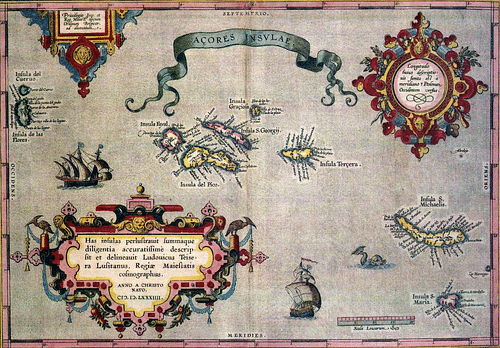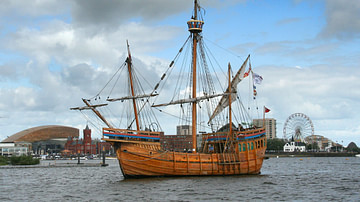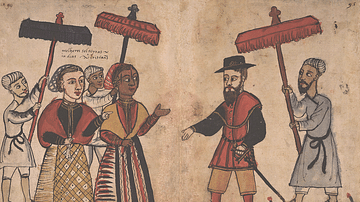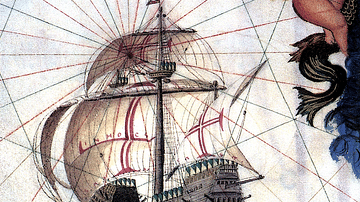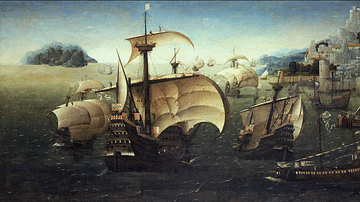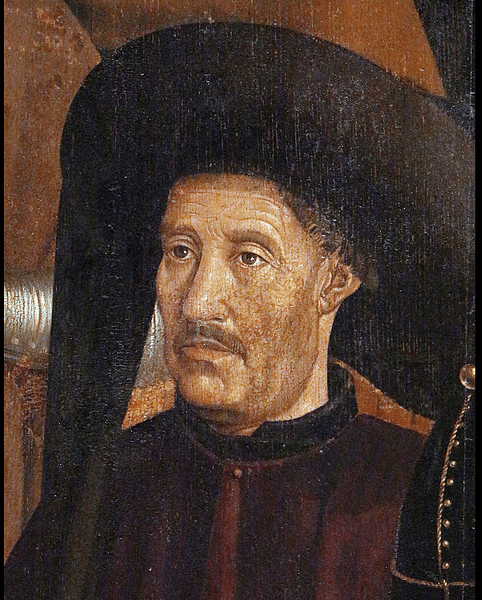
Prince Henry the Navigator (aka Infante Dom Henrique, 1394-1460) was a Portuguese prince who famously helped capture the North African city of Ceuta, sponsored voyages of exploration with the aim of building colonies in the North Atlantic and West Africa, and began the Portuguese involvement in the African slave trade.
Prince Henry earned his title ‘the Navigator’ because he assembled a learned group of designers and maritime experts to design new ships, maps, and navigational instruments. Henry then funded expeditions to use this knowledge to sail the High Seas and explore the West African coast. Building up a massive body of maritime know-how with each expedition, Henry oversaw the first stages of a process that gained the Portuguese a global empire.
Early Life & Ceuta
Prince Henry was born in 1394, the third son of John I of Portugal (aka d. João I, r. 1385-1433) and Queen Philippa, who was English. Perhaps not quite the enlightened and learned scholar his Renaissance-era legend extolled, Henry was certainly a devout Christian. Wearing a hair shirt and dedicating himself to a life of celibacy, Henry did not marry or father any children. His life was dedicated to exploration, empire, and defeating Muslims wherever they were found. He loved pomp and ceremony, the chivalrous code of knights, and he was known for his extravagant parties.
In 1415, the Portuguese attacked the rich Muslim city of Ceuta in North Africa in a renewal of Christian-Muslim hostilities. The city was well-fortified, but the Portuguese had let it be known their fleet intended to attack the Dutch over a trade dispute and so Ceuta was unprepared. The force had nearly 20,000 men, including over 5,000 knights. The king, Prince Henry, and his brothers jointly commanded this extraordinary force that was attempting to rekindle the flames of the old crusades. Things did not start well. First becalmed, thick fog and unpredictable winds then split up the armada before it reached its destination. When the army finally landed, the Portuguese were able to force their way into Ceuta’s fortress through sheer weight of numbers with Henry in the thick of the action. The city fell in a day on 22 August, and a massacre and chaotic round of looting followed.
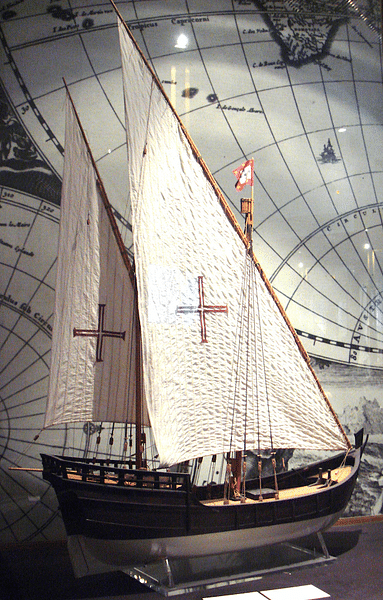
Henry was knighted for his key role in the capture of Ceuta, and he was then made responsible for the defence of the city by his father. In 1419-20, the Prince resisted a massive counterattack on the city. Henry used Ceuta as a base from which to launch periodic attacks on the Muslim settlements along the coast - perhaps this was the real purpose in capturing the city. Enemy ships in the Mediterranean were ruthlessly sunk. In 1415, Henry was made the Duke of Viseu and in 1420, via a papal bull, he was appointed the administrator of the Order of Christ, an offshoot of the now-defunct Knights Templar. Immensely rich thanks to his royal connections and estates, Henry raked in cash from many projects, including a monopoly on the manufacture of soap. This was all very well and satisfied the prince’s religious zeal and lust for knightly endeavour, but he wanted more. He wanted the world.
The Caravel & Lateen Sail
Henry the Navigator was especially keen for Portugal to be at the forefront of European territorial exploration, to challenge the Islamic caliphates in North Africa and the Middle East, and perhaps find the legendary Christian kingdom of the east with a ruler called Prester John, most likely somewhere in Ethiopia in East Africa. At Sagres on the southern tip of Portugal in 1419, Henry assembled a team of experts in cartography, navigation, astronomy, mathematics, and ship design. The group included both Christians and Jews, and they were not shy to use Arab sources of information. Contrary to legend, there was no navigational school here. Up to that point, European sailing vessels had depended on either teams of rowers or fixed sails or both for their propulsion; the square-rigged barca being the most common. The problem with these square-rigged ships was that they could only effectively sail with a direct wind from astern.
Prince Henry charged his team with designing a new type of ship, one which could sail both with and against the wind and which could explore dangerous unknown rocky shores, inland waterways, and the open ocean. The answer they came up with, based on a type of Portuguese fishing vessel, was the caravel (caravela in Spanish and Portuguese).
The caravel was a type of medium-sized ship which had a shallow draught and lateen or triangular sails. It was fast, maneuverable, and only needed a small crew to sail. The early caravels were small and weighed no more than 80 tons, but later versions did increase to 100-150 tons. They had a stern rudder, two or three masts, and a distinctive raised forecastle and sterncastle. A caravel had a typical length-to-beam ratio of 3.5:1.
The lateen sail was a crucial part of the design and of Henry’s plans for exploration. The name of this triangular sail derives from ‘Latin’ even if it was inspired by the sails of Arab sailing vessels, particularly the dhow with its single lateen sail. Flexible lateen sails permitted a vessel to sail within five points off the wind and even to tack (move in a forward zigzag) against a headwind.
To gain more cargo space, the caravel design was tweaked to create the round caravel or caravela redonda. This type was larger and wider than a normal caravel and could weigh up to 300 tons. The round caravel usually had square-rigged masts for greater speed and a bowsprit with spritsail. A third variant was a four-masted caravel designed for use as a warship. Typically, three masts carried lateen sails and one was square-rigged.
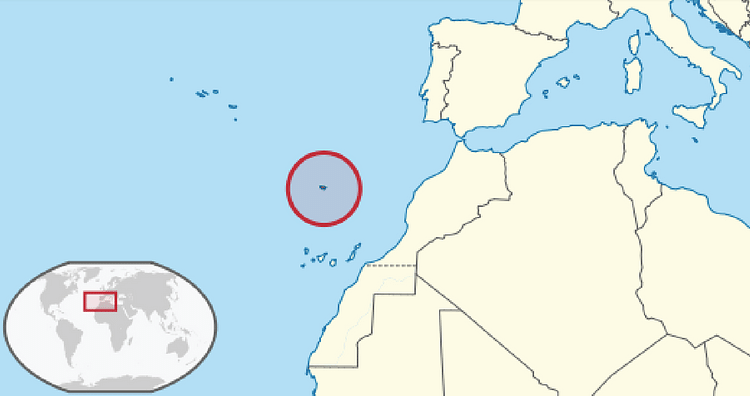
The First Colony: Madeira
Henry the Navigator then set about funding expeditions using his new ship design, and it brought rewards, even if he himself spent very little time on water and none at all on an ocean-going voyage. Two captains of vessels sponsored by Prince Henry, who were meant to be raiding the Moroccan coast, landed at Porto Santo in the uninhabited Madeira archipelago during a storm in 1418. The accidental explorers quickly realised the potential of the place - one later sailor described it as "one large garden" (Cliff, 71) - and reported back to Henry. In 1419 the Portuguese Crown formally declared possession of the North Atlantic island group, located some 800 km (500 mi) from the African coast. Governorship of Madeira was awarded to Prince Henry. The Portuguese military order, the Order of Christ, whose head was Henry, was granted exclusive rights there. The islands were colonised from 1420, and Henry was directly responsible for the idea of growing sugar cane on the islands, creating a plantation system that would eventually be copied in colonies elsewhere but especially in Portuguese Brazil.
The Fall of Ceuta
To balance this success, Prince Henry did have to endure two recurring failures. The first was his attempt to control the Canary Islands. The armies of Castile and the indigenous Guanches repelled the Portuguese three times, and Henry had to settle for islands elsewhere. Meanwhile, Ceuta proved something of a disappointment, too, as the city lost all its trade following occupation. Muslim merchants and trading vessels simply diverted further along the coast to Tangiers. Henry managed to persuade the king to fund another campaign, but Tangiers was much bigger and better defended than Ceuta, and without appropriate siege engines, the expedition proved a dismal failure in 1437. Henry was obliged to hand over his brother Ferdinand as a hostage in order to permit a Portuguese retreat. Part of the deal was to give up Ceuta, but Henry reneged on the agreement, and his brother died in a Muslim prison. As raids continued on North African ports, the lure of West Africa began to sway the prince’s territorial ambitions. Portugal would now focus on the Atlantic.
Rounding Cape Bojador
West Africa offered unsubstantiated opportunities, perhaps resources of its own but very likely access to trade networks within the interior of that continent which bypassed the Muslims in North African. Ever since Mansa Musa I (r. 1312 to 1337), ruler of the Mali Empire, had visited Cairo in 1324 and wowed everyone with the quantity of gold carried by his entourage, Europeans had been intrigued by the idea that the heart of Africa contained fabulously rich gold mines. A major obstacle to the plan of accessing the region was a geographical one: how to sail around Cape Bojador and be able to make it back to Europe against the prevailing north winds and unfavourable currents? It was also believed by many Portuguese sailors and others that the waters beyond the cape were beset with storms, terrible fogs, and unimaginable sea monsters.
Over 12 years, Henry had funded 14 expeditions with the enlistment of Italian bankers and the objective to round the cape. Henry’s ships all carried white sails emblazoned with the red cross of the Templars, but the emblem did them no good, and all 14 fleets failed in their target. The lateen-rigged caravel was the answer to these problems, along with a good bit of daring. By setting a bold course away from the African coastline and using winds, currents, and high-pressure areas, the Portuguese found they could safely sail back home. The treacherous Cape Bojador was thus navigated in 1434 by the Portuguese explorer Gil Eannes.
Prince Henry then instructed all subsequent expeditions to carefully record their experiences. Consequently, a priceless scientific record of winds, tides, currents, and coastlines was built up, and evermore accurate charts were drawn of Africa and kept in Lisbon. The Portuguese were notoriously reluctant to share their findings with anyone else, and this nautical information effectively became a state secret. There were, too, additions to zoological knowledge. For the first time, Europeans understood where migratory birds flew when they left Europe, countless new species were identified and new peoples encountered.
The Azores & Beyond
The next target on Henry’s colonization list was the Azores archipelago (Açores) further out in the Atlantic Ocean. The process of colonization began there in 1439, with overlordship divided between Prince Henry and the regent Prince Pedro, although after the latter’s death in 1449, Henry took over the whole archipelago. Both Madeira and the Azores were parcelled up into captaincies for agricultural and trade development, a model that would be copied in many subsequent Portuguese colonies as the empire spread from the Americas to East Asia. The Atlantic islands became stepping stones for voyages that went even further afield, eventually around the Cape of Good Hope in southern Africa and beyond to Asia. Prince Henry profited immensely from the resources and trade opportunities this colonization brought to the Portuguese Crown and himself personally.
Exploiting Africa
Henry the Navigator continued to send expeditions to explore the western coast of Africa and extract anything of value. Gold, hides, and some foodstuffs were exchanged for bales of cloth. The quantities were not great but enough for the Portuguese crown to begin minting their famous solid gold coin, the cruzado, from 1457. The year 1444 saw the first Portuguese expedition which took slaves from Africa - men, women, and children - after a raid on settlements on Arguin Island. This was the site of the first Portuguese feitoria (fortified trading station) overseas. 240 slaves captured from this first raid were paraded naked at the docks of Lisbon. Other states had long been slave-trading in Africa, but this dockside spectacle was an ominous omen of the human tragedy to follow in subsequent centuries. The very next year, another and larger slave-hunting expedition was launched, and others followed so that some 20,000 slaves were brought to Lisbon in the next 15 years. Very quickly, African peoples began to see the bewildering new threat to them from these strange visitors with their odd white skin, gleaming armour, and gunpowder weapons.
The slave trade brought Henry enrichment and glory. Strange as it seems to us today, Henry was not criticised for this trade but, on the contrary, widely congratulated and applauded for finding a new source of wealth, damaging Islamic trade networks, and giving pagans the opportunity to know the Christian faith. These arguments were used to justify colonialism in the minds of those who conducted it for the next 400 years. Significantly, the Pope described Henry in a papal bull as "our beloved son" and a "true soldier of Christ" (Cliff, 99). The 'Navigator' was at the height of his fame and power, but he was, of course, mortal.
Prince Henry died in 1460, and he was given an impressive tomb in the Batalha Monastery in central Portugal. He did not, then, live to see the incredible extent of the empire he had begun to forge. More Portuguese exploration followed, and more and more colonies joined the Atlantic islands as tiny Portugal wove a web of trading ports across the globe from Brazil to Japan. The chapel Henry had founded at Belém outside Lisbon remained the last point of home that mariners saw before they left Portugal to reach these far-flung colonies. A tradition arose that crews would say their prayers in this chapel on the eve of their departure, asking their god for a successful voyage and a safe return home. Henry the Navigator, meanwhile, became a legendary figure thanks to his achievements and such late-medieval chronicles of his life as written by Zurara (c. 1410 - c. 1474). Even in the 15th century, some critics did note that the prince was rather too interested in wealth and harking back to the long-gone days of the crusades, but he was, nevertheless, widely celebrated for centuries as the founding father of Portugal’s maritime empire.

